In a rush? The best plagiarism checker for most writers is Grammarly. In this article, we profile your options.
To find the best plagiarism checker for 2024, we researched dozens of tools checking text like blog posts, book chapters, articles, and academic texts. Our tests found that Grammarly is the easiest to use for general-purpose plagiarism checks. ProWritingAid is cheaper if slower. Those in academia look for a plagiarism checker for research papers should try Scribbr.
At A Glance: Our Top 2 Picks For Plagiarism Checker
- Best Plagiarism Checker: Grammarly
- Best Alternative: ProWritingAid
When I trained as a journalist, a senior lecturer underlined the importance of attributing our sources, statistics, and findings. He pointed to the New Republic journalist Stephen Glass who was exposed for making stories up and for plagiarism. Several years later, while studying for a post-graduate degree, my tutor explained how easily a student can fall foul of accidental plagiarism by incorrectly citing sources.
Whatever your specialism, nothing can damage a writer’s reputation or student record more than an accusation of plagiarism. While most issues are unintentional, unlike Stephen Glass’s, even a hint of an accusation can impact your grades or livelihood.
So, you must turn in articles, essays, papers, and assignments plagiarism-free and with correctly attributed citations and sources to avoid the consequences of plagiarism. Bloggers, writers, essayists, students, and writers of all types should use the best plagiarism checker available before submitting or publishing their work. These plagiarism checkers don’t take long to use and will help you confidently submit or publish.
If you’re worried about plagiarism, unintentional or otherwise, fear not. This article profiles the best free and paid plagiarism checkers on the market. We also explore the accuracy of these plagiarism detection tools, explain who they’re for and offer helpful tips for getting more value from them.
Contents
- 1. Grammarly
- 2. ProWritingAid
- 3. Copyscape
- 4. Quillbot
- 5. Writer.Com
- 6. Turnitin
- 7. Scribbr
- 8. Quetext
- 9. Plagiarism Check
- 10. Paper Rater
- 11. Unicheck
- 12. PlagScan
- 13. DMCA Scan
- 14. Plagiarism Checker X
- 15. Chegg
- 16. Duplichecker
- What Is The Best Plagiarism Checker?
- How Does Plagiarism Software Work?
- How Do I Choose the Best Plagiarism Checker?
- The Best Plagiarism Checkers Video Round-Up
- Why You Can Trust Us
- Our Testing Criteria
- FAQs About The Best Plagiarism Checkers
1. Grammarly
Pricing: $30 to use its plagiarism checker. Unlimited checks.
Use for: Checking your articles or articles by other writers

The Grammarly plagiarism checker is part of its premium plan only. You can access Grammarly for free and check your paper, Docx MS Word file, or web page for grammar errors, but you’ll need to upgrade to check for plagiarism. Although it has a popular grammar add-on or plugin for most browsers and apps, plagiarism reports take place inside the web app.
I copied and pasted some writing from a dot txt file into Grammarly. It gave my document a plagiarism score. The report picked up intentional plagiarism and an improperly cited quotation.
I like Grammarly as a plagiarism checker as it identifies instances of duplication in my work and across this site. I also don’t have to worry about word count, as the plagiarism checker is part of a monthly subscription, not billed per page. Its insights help with self-editing and ensure I publish original work, which is good for ranking higher in SERP (a search engine results page).
Grammarly is available on iOS and Android, mobile and desktop. It’s an ideal solution for professional writers and students worried about potential plagiarism. It doesn’t consider print books, like academic plagiarism software.
Tip: If you’re in school or university, avail yourself of a Grammarly student discount.
I use Grammarly’s plagiarism checker to vet work by freelance writers that I’m considering hiring. If you want to learn more, read my comprehensive Grammarly review.
We tested dozens of grammar checkers, and Grammarly is the best tool on the market today. It'll help you write and edit your work much faster. Grammarly provides a powerful AI writing assistant and plagiarism checker.
2. ProWritingAid
Pricing: $70 per year, Plagiarism checks billed on a credit basis.
Use for: fiction, books, as a Grammarly alternative
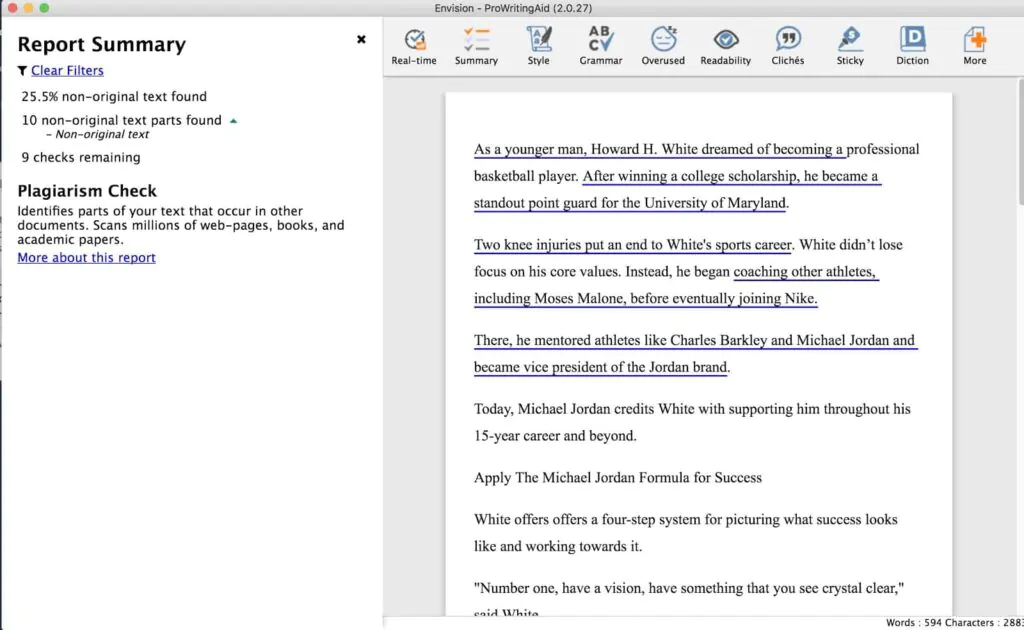
ProWritingAid is a versatile tool and a good choice for writers who want to check their work for plagiarism but are on a tight budget. The free trial version of ProWritingAid is relatively limited. To try the plagiarism checker, you must pay $70 per year and purchase credits to run a report. It’s still cheaper than Grammarly.
While writing my last book, I used the plagiarism checker to scan book chapters for missing quote citations. I uploaded an MS Word document into the web app to check for plagiarism. You can copy and paste text or open writing documents on your computer.
I was somewhat impressed with the accuracy of the reports, but I found it slower than Grammarly. It doesn’t consider academic or print publications. The billing per page model is also less suitable for content publishers. I use ProWroWritingAid for long-form work only. To learn more, read our ProWritingAid review.
ProWritingAid is a powerful, accurate grammar checker and style editor. It's suitable for non-fiction and fiction writers and doesn't require a monthly subscription. Save 20% per month or year.
3. Copyscape
Price: $4.95 per month or 3 cents per search
Use for: checking online work and protecting your website
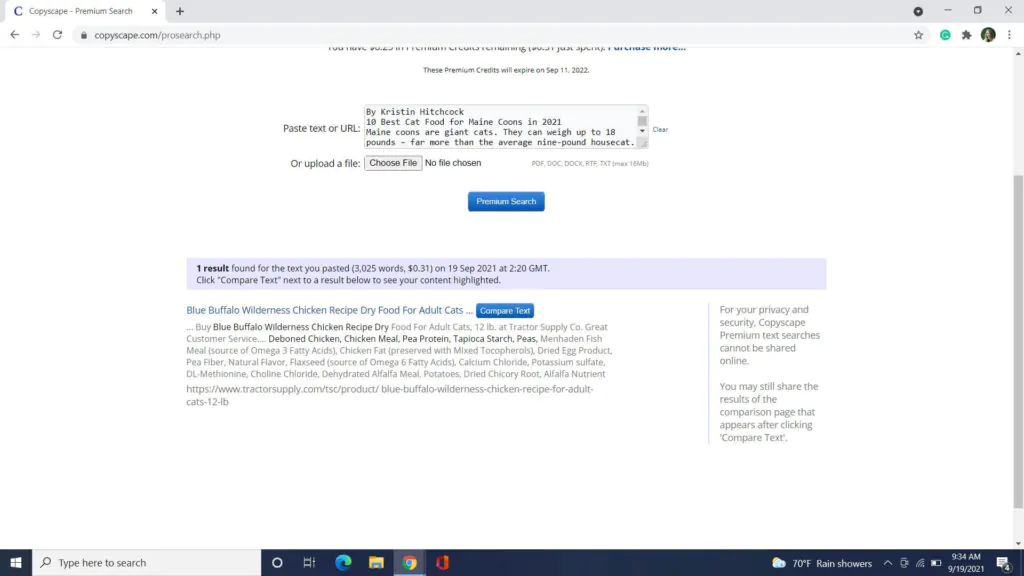
Copyscape is a popular type of plagiarism detection service founded by Gideon Greenspan in 2003. You can enter an article’s URL into Copyscape and check if it matches published web pages for plagiarism. Essayists can also paste their work into Copyscape to check for accidental plagiarism against online content only.
Copyscape is a valuable tool for maintaining the health of your site and mitigating copied content if you publish on a website or blog regularly. You can connect it via an API tool and configure notifications for existing content. That sets it apart from Grammarly as it’s a type of proactive plagiarism software rather than reactive (i.e. it can alert you).
I used Copyscape as a type of plagiarism detection software for this site. I connected it to my sitemap, and I was disturbed that another website had ripped off one of my online reviews. I was concerned about the SEO implications of plagiarism. So, I immediately contacted the site and asked them to take down the article. After receiving no response, I initiated a DMCA takedown request.
These days, I use Copyscape in conjunction with Grammarly and ProWritingAid. Read our Copyscape review.
4. Quillbot
Price: $20 per month for 20 pages, then $7.50 per 10 pages
Use for: Plagiarism checks, citations
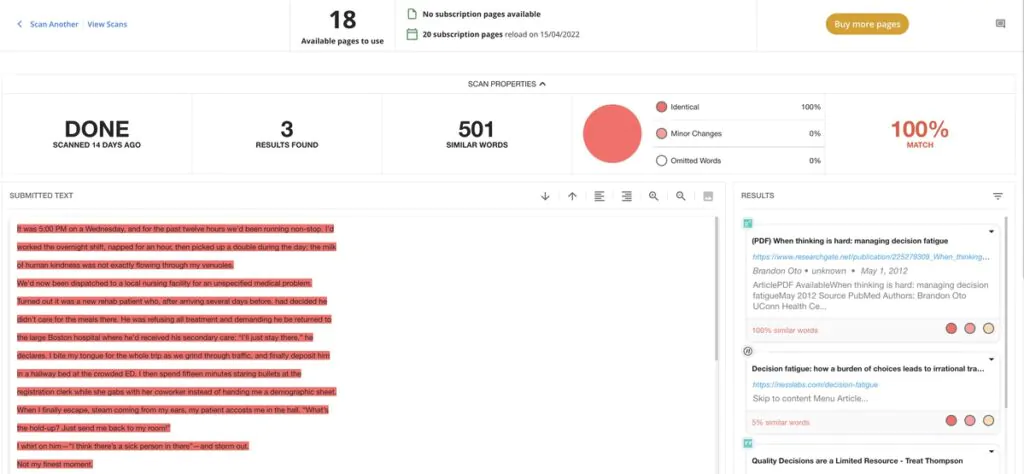
Quillbot contains a great plagiarism checker. It’s better for checking academic works and essays than other tools here. We pasted several academic papers, which immediately caught the sources for these PDFs.
Quillbot includes a useful citation manager too. Paste in a link to any research paper or source, and it will correctly generate citations, saving academics and essayists time formatting papers. It can also support paraphrasing and summarizing content. Thanks to a correctly formatted bibliography, these features can help a student or academic avoid plagiarism.
However, it’s less suitable for freelance writers and content publishers. It works on a per-page basis. You can check 20 pages for the monthly subscription (about 5000 words). After that, it costs $7.50 to check 20 pages, approximately 250 words per page. So if you’re checking lots of essays, it could get expensive. I intend to use Quillbot for my next non-fiction book to create my citations and references. To learn more, read our Quillbot review.
5. Writer.Com
Pricing: Free version available
Use for: working with a team
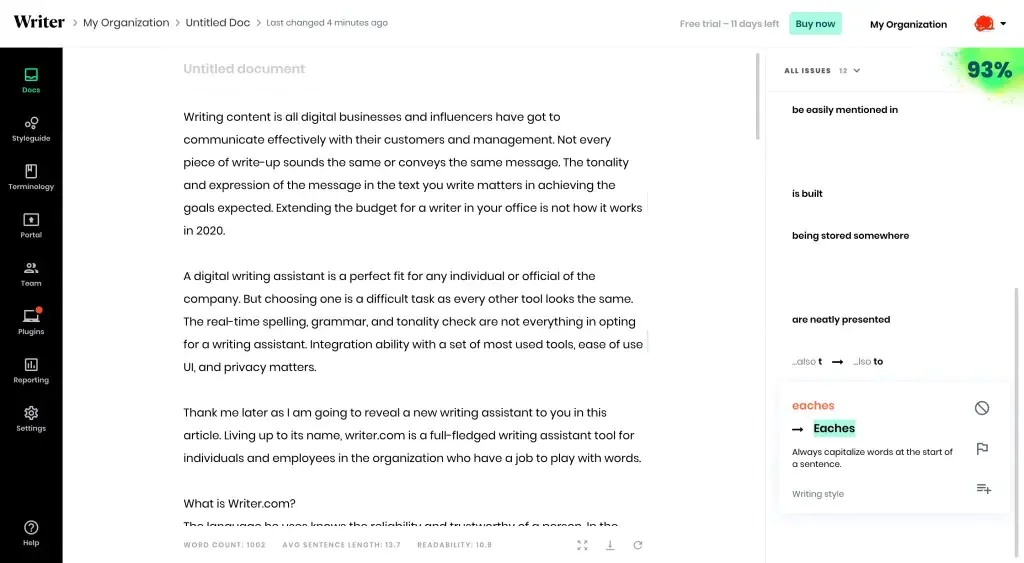
Writer.com is a newer plagiarism detector with some comparable features to Grammarly. It’s built with businesses in mind with additional security and compliance measures compared to typical writing software.
It also supports the AP style guide. It checks documents for accidental plagiarism or otherwise. If Writer.com finds content used elsewhere, it will highlight the text and provide a URL for you to check. It’s also cheaper than Grammarly at $11.99 per month. You can try out the plagiarism checker for free too.
Thanks to advanced collaboration features, Writer.com is a reasonable choice for those who work with other team members. However, I polled several writers who said they found Grammarly more accurate and intuitive. I don’t use this plagiarism tool as much. To learn more, read our Writer.com review.
6. Turnitin
Pricing: Unavailable unless your academic body uses it
Use for: checking essays and papers in academia

When you ask which plagiarism checker or detection tool universities use, they point to Turnitin. While there is no way to check this from the student-facing side (without submitting a document to a teacher), here’s what you should know about using Turnitin for academic integrity.
Turnitin is a software solution for schools sold by a business. According to Turnitin’s sales materials, every document submitted to a teacher through the portal is scanned and checked.
Turnitin stresses it offers more than plagiarism detection. It provides a comprehensive and proprietary scoring system for each piece it scans. The brand offers a “similarity index,” a percentage score, and a report that gives teachers more insight into the work.
Tip: If your teacher uses Turnitin, run your paper through another plagiarism detection software before submitting it. This is a good practice before submitting any paper, but absolutely essential if your teacher uses Turnitin. Unfortunately, most people can’t use this tool directly, but a workaround exists, as I’ll explain in our following selection. To learn more, read our Grammarly vs TurnitIn comparison.
7. Scribbr
Pricing: $19.95 to check 7,500 words
Use for: accessing Turnitin’s plagiarism checks
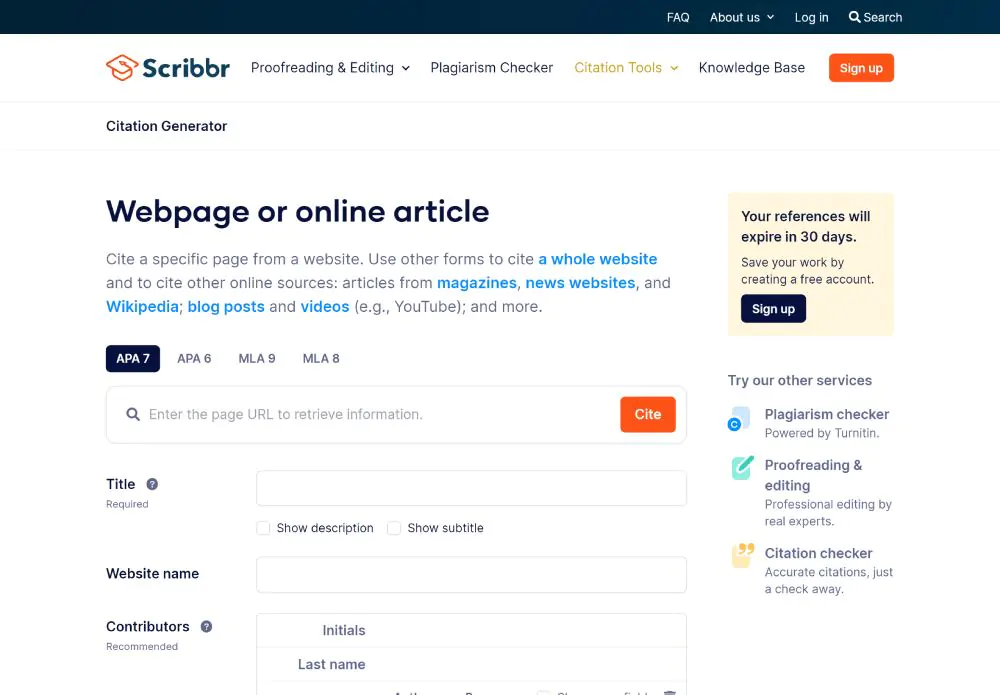
If you need access to Turnitin but can’t get it, consider Scribbr. It’s powered by Turnitin and scans web pages and over eight million publications. That sets it apart from other tools here. Our reviewer found Scribbr intuitive, insightful and relatively accurate. It also includes a citation generator. The grammar check lags behind Grammarly, though. It’s more suited for students and essayists than publishers and website owners due to the billing model. To learn more, read our Scribbr review.
8. Quetext
Price: From $14.99 per month for 200 pages
Use for: academic plagiarism searches
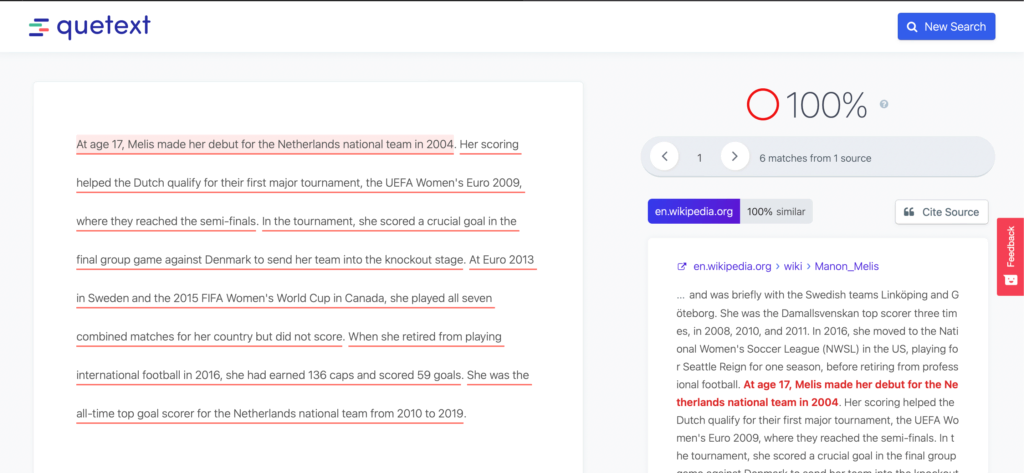
QueText is built for teachers and academics. Like Scribbr, it checks for plagiarism against web content and online textbooks.
QueText’s primary selling point is its DeepSearch technology, which runs plagiarism checks against gated content. It took us about two minutes to review a short essay, which is somewhat slower than other plagiarism checkers. Interestingly, this DeepSearch feature found references on Twitter and web.archive.org. Its results are more in-depth than most tools here, as they didn’t consult as many sources. QueText supports multiple languages, including French, Spanish, Polish, Dutch and German. It also includes a citation assistant. Read our QueText review to learn more.
9. Plagiarism Check
Pricing: 15 and 30 cents per page, depending on your plan
Use For: Educational institutions, businesses, and individual users
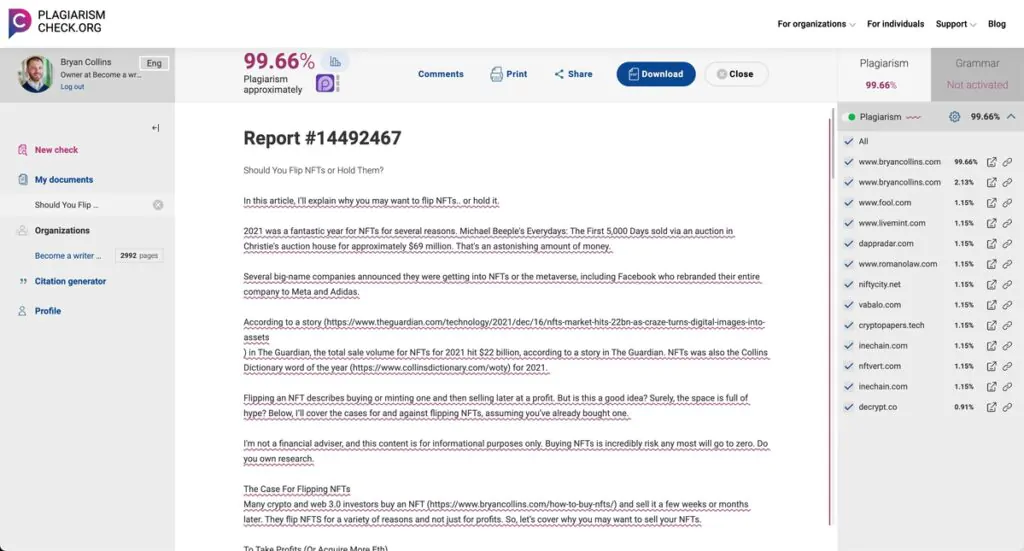
Plagiarism Check is an accurate type of plagiarism software that uses algorithms to spot unoriginal work even after it’s spun.
Signing up for an account is easy, and Plagiarism Check gives you one free scan so you can get a feel for the platform. The dashboard is intuitive, and you don’t have to go through a learning curve. There’s a menu that also offers a citation generator on the left. This feature makes Plagiarism Check a practical option for students because you can scan for plagiarism and create citations within seconds.
The citation creator can also help avoid accidental plagiarism. This way, when you hand in your assignment to your school or college, you can be sure there’s no copied content. Its reports are easy to understand too. I tested this tool extensively and found it a good choice for those in academia, more so than content publishers and online writers.
10. Paper Rater
Pricing: Free
Use for: checking essays if you’ve no budget
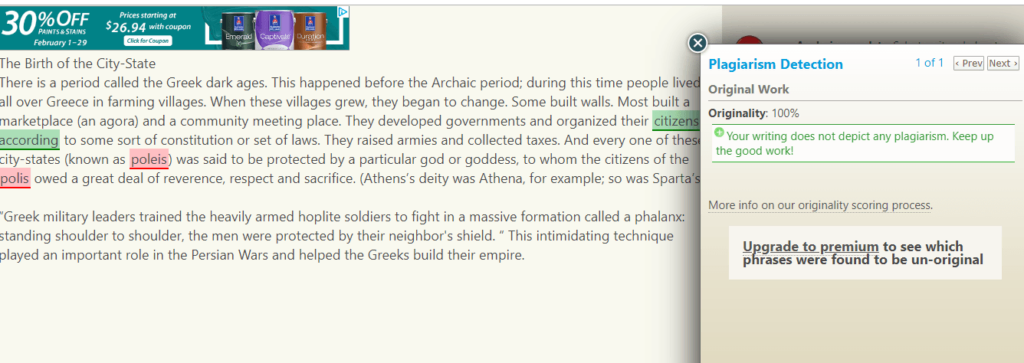
This free online plagiarism checker asks questions about your paper before checking it. To use PaperRater, indicate your grade level, the type of paper, and other factors.
You can paste the text into Paper Rater and check a few hundred words for plagiarized text for free. Our reviewer liked that this tool is free but found it missed some obvious plagiarism errors in a test article. He also didn’t find it as intuitive as competitors. To learn more, read our PaperRater vs Grammarly comparison.
11. Unicheck
Pricing: Varied; I was quoted $15 to check a passage for plagiarism and $99 others
Use for: checking articles on a budget
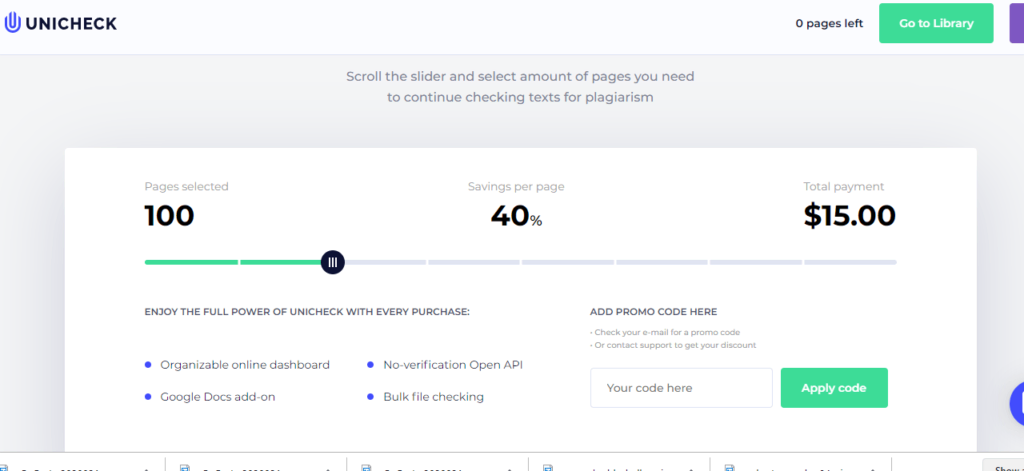
Unicheck is a plagiarism detection software with plenty of features but requires more details to check original content. While the other checkers here allow you to drop in a passage and go, this one requires a login and some additional details. You can check 200 words for free (probably not enough for any student!)
I pasted in some extracts from articles on this site. A Unicheck report presented me with some links to check. However, I found Copyscape’s reports more helpful for this type of analysis.
12. PlagScan
Pricing: You get 20 credits free – after that, 100 credits will cost you $12.00
Use for: checking your essays and papers

PlagScan is a relatively robust plagiarism checker, in existence for over ten years. You can sign up with a Google account or your email and access the web browser for free. It works on a credit system basis, but you can still check up to 2,000 words without paying.
Signup is fast, easy, and does not require a credit card for the trial period. Once my email was verified, I received immediate free credits — enough to check the passage and some future papers. You can upload word documents, input text directly or add a URL. I tried pasting a URL into the tool and encountered connection errors. Instead, I coped the bulk of my article into the device.
It took about one minute to scan my document. Then, it presented me with a report and links to potentially plagiarised content. I was unaware of one of these links. It revealed someone had copied original content from this site and put it into a PDF online.
If you want an accurate free plagiarism checker for a once-off project, this could be a good choice. You can check 2,000 words, which is the length of a typical essay. Then, you can update to a premium plan starting at $5.99 per month, depending on the level of analysis you want.
13. DMCA Scan
Price: Free for two scans
Use for: raising DMCA takedown requests
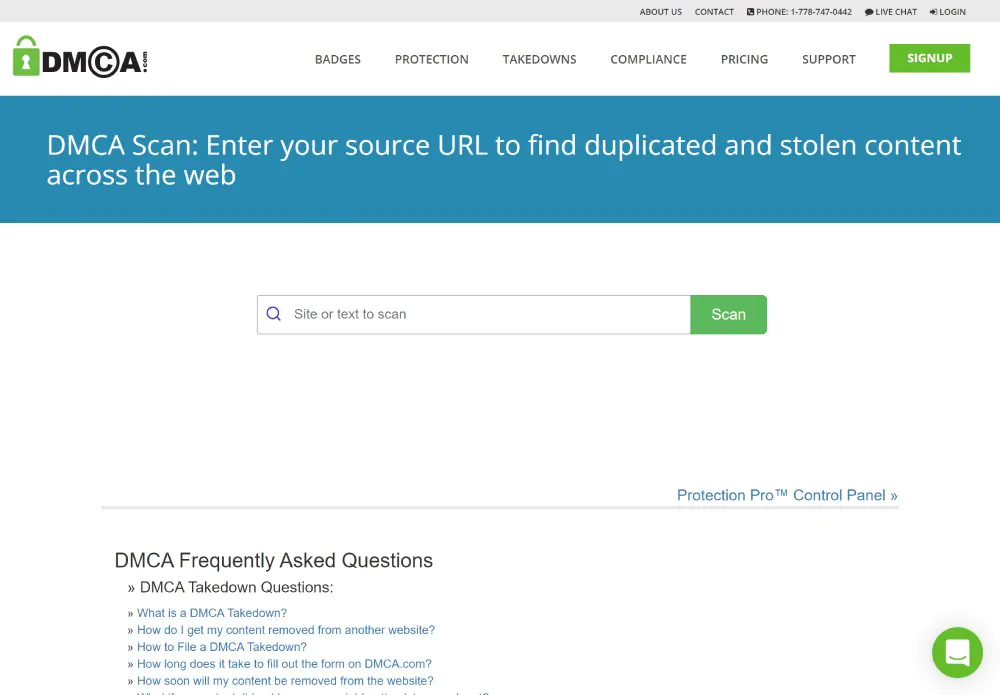
After finding an instance of plagiarism or duplicate content, you can issue a DMCA takedown request via Google. Alternatively, you can use a site that scans the web for duplicate content issues. I pasted the website address for this site into DMCA scan.
It found three examples of duplicate content on other sites. One of these was an Amazon book description. It missed some other examples I was aware of. This information is helpful before submitting a DMCA takedown request, but I wouldn’t solely rely on this tool as a content publisher.
The company behind it also claims to help with DMCA takedown requests for $199 but considering these are free to raise with Google and other search engines, I’m unsure of the benefits of paying for this service.
14. Plagiarism Checker X
Price: Free/$39.95
Use for: Checking academic essays and articles in bulk, non-English checks
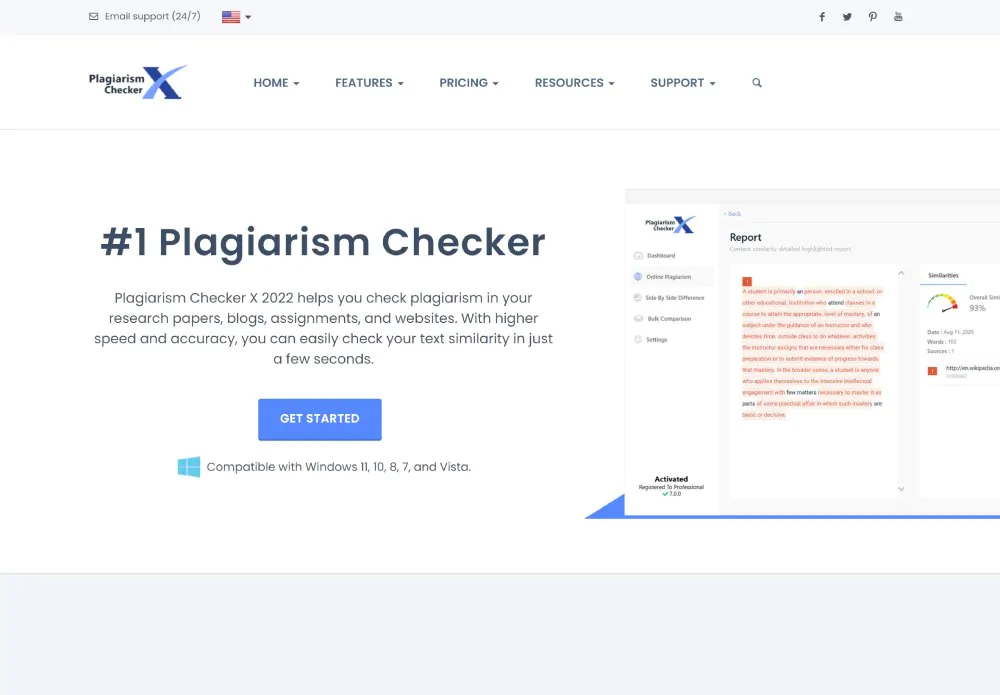
Plagiarism Checker X is a well-known “text similar checker” created by Rashid Ali in 2012. It’s popular with students and academics. It claims customers including Trinity College, Ohio University and JM Field Marketing. You can paste content or essays directly into the tool or paste a URL for an article.
It scores an article a percentage and provides accurate, in-depth results based on a database of published content. Unlike Grammarly, you don’t have to pay a monthly subscription. It costs $39.95 once you decide to upgrade from the free version.
I particularly liked that it supports more than English. I was also impressed by the bulk comparison tool, which checks multiple articles or essayists at once. This is ideal for people who write and publish lots of content. However, Grammarly is still a better choice due it its price point and feature set at this price point. Read our Plagiarism Checker X vs Grammarly comparison.
15. Chegg
Pricing: free trial/$14.95 per month
Use for: exam prep, checking home work
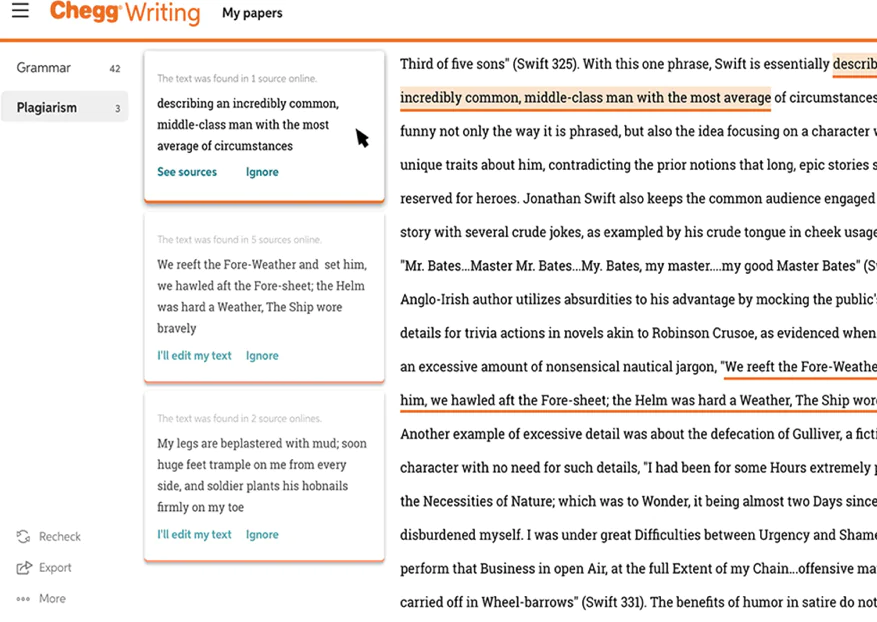
Chegg is a service for students who need help with homework and preparing for exams. After signing up, students can access a plagiarism tool. Unlike other tools featured here, students can scan as many pages as they want as part of a monthly subscription, a model similar to Grammarly.
Chegg syncs with Google Drive too, meaning students can write their essays and then check for plagiarism relatively easily. The plagiarism checks aren’t as deep as competitors though. Our reviewer liked its citation manager. Chegg offers a comparable free tool called Easy Bib for managing citations. To learn more, read our Grammarly vs Chegg comparison.
16. Duplichecker
Pricing: Free/$25
Use for: Content publishers who have free access to a plagiarism checker

Duplichecker is a freemium plagiarism checker. You can check up to 1,000 words for free using the online tool without setting up an account. Simply copy and paste text or upload an MS Word, dot TXT or another file format.
The free version is monetized via advertising. Sign up for the paid version to turn that off and check more pages. It’s more suitable for content publishers and those who write content online than students, i.e. as a Copyscape alternative.
We noticed some quirks after copying in text, whereby it inserted extra formatting and spacing errors. These quirks complicated editing our text, but it’s fine for quickly vetting a document for plagiarism without paying or signing up for any tools. We tested two published articles by copying and pasting their text into the tool. The plagiarism report correctly caught issues with one and surfaced the original URL. For our second test, it failed to identify that the article was already published online.
What Is The Best Plagiarism Checker?
Grammarly Premium offers the best general plagiarism checker for checking articles, essays and other types of writing. It’s easy to use and relatively affordable.
Grammarly and ProWritingAid also offered additional perks, including proofreading and insights into grammar, alongside a plagiarism report. They can also help with SEO if you’re worried about duplicate content.
If you write fiction, consider using ProWritingAid as a useful plagiarism detection tool. It offers a combo of comprehensive detection and editing tools. The free version of PlagScan was also a favourite, and I picked up everything I expected. Quillbot is a decent, cheaper alternative.
Those in academia should opt for custom plagiarism software like Turnitin. Quetext and Scribbr are two good options if Turnitin is unavailable and you want to avoid self-plagiarism or accidental plagiarism. Scribbr can also serve as the best free plagiarism checker but the results are limited versus the premium version. Plagiarism Checker is also excellent. Arguably, you could use it to check academic works and other types of writing.
Copyscape is a good plagiarism checker for web publishers who want to protect their SEO-optimized content or site from plagiarism by unscrupulous website owners. Use this if you need to prepare for a DMCA takedown request. Add one or more plagiarism detectors to your writer’s toolbox, and you’ll never have to worry about the work you’re submitting again.
How Does Plagiarism Software Work?
Modern plagiarism checkers use a custom algorithm to scan the web for similar content compared to the writing under examination. Plagiarism checkers look for direct quotes and similar wording between your document and published, accessible writing. Common word pairings and uses are not considered plagiarism — a detector that is so sensitive it picks up common word combinations would not be useful.
These tools typically present a report with links to duplicate content so you can check sources or follow up on the copyright violation. Some checkers run deep scans against academic journals, social media and online archives. They require internet access to work.
Plagiarism detectors are available online from various brands and are built using custom algorithms. Writers can try some plagiarism software for free and check a sample of their work. Premium plagiarism checkers offer deeper scans, more advanced reports and plagiarism scores. These tools charge on a per-page/word basis or via a monthly subscription. They check a document in four ways.
| IMAGE | PRODUCT | |
|---|---|---|
|
Best Plagiarism Checker
 |
Grammarly
|
Claim My Discount → |
|
Best Alternative
 |
ProWritingAid
|
Claim My Discount → |
1. Keyword Analysis
This is similar to a search engine. You input a document, and the software program scans for instances of that same word in the same place. If the software program finds that you use specific words in the same places as other articles, it will register a plagiarism hit. The downside is that this option does not identify paraphrasing, which could also be plagiarism. Paraphrasing is where the ideas are the same, but the words are positioned differently, which is not enough to trigger a hit from this program.
2. Phrase Analysis
Instead of looking for a single word, this tool looks for strings of words that are ordered the same. For example, anything with more than five words in the same order might trigger a match. One downside of this method is that if the words are ordered differently, or swapped out for synonyms, that work might evade this program.
3. Content Matches
This method looks at the writing style, comparing it to other documents. This is not a word-for-word analysis but instead looks for similar structure, style, and phrasing to determine hits. If the article’s overall structure, feel, and tone are similar, then this program might trigger a hit. This program can get overzealous and register content matches that might not be plagiarism, particularly if two writers have similar tones and styles.
4. The Fingerprint Method
The fingerprint method looks at word fragments that appear in a document in the same order. The goal is to look at the words used and the order of the fragments to see if the document has been lifted and pasted from another source. For example, if someone copies an article, pastes it, and then tries to expand on it, alter a few words, and add more paragraphs, the overall fingerprint is still the same. This will trigger a plagiarism hit.
How Do I Choose the Best Plagiarism Checker?
Deciding on the best plagiarism checker depends on what you’re writing. For example, a student needs a different type of plagiarism report than a blogger or content writer. The former cares more about checking against published academic works, whereas the latter is more interested in linking to sources online.
If you get a positive result from a plagiarism checker, correct the problematic parts by including links, and citations, or revising them. If you submit an essential document without checking, you could end up in trouble and with a failing grade, so taking this extra step is a critical part of the writing process.
The Best Plagiarism Checkers Video Round-Up
In this video, I profile some of the best plagiarism checkers. You can watch over my shoulder as I try and test them and run plagiarism reports before picking my favorite. Below, I got into more detail about these and other tools.

Why You Can Trust Us
I’ve written and published dozens of articles for newspapers, magazines, and online publications, including Forbes and Lifehacker. I’m also a best-selling non-fiction author, a trained journalist, and a copywriter.
I depend on plagiarism software for three reasons. Firstly, I use it to check the work of new freelance writers who submit articles to this site and others. It helps me with hiring decisions. Secondly, I use it to check my work for unintentional instances of plagiarism and missing citations and links. Thirdly, I use these tools to check if my content has been plagiarised by someone else.
Our Testing Criteria
We update this roundup of the best plagiarism checkers regularly. We test critical features by checking MS Word documents, blog posts, essays, articles and even book chapters.
These writing samples range from several hundred to several thousand words. Typically, we use the web, desktop and browser apps and plugins, factoring in price, ease of use and functionality. We’ve reviewed many plagiarism checkers individually and included links to those reviews.
FAQs About The Best Plagiarism Checkers
Does Google have a free plagiarism checker?
Google does not have a free plagiarism checker. The closest you’ll get is Google Scholar. Paste your text into this search engine, and it will search for this text in academic papers and journals. However, it’s not meant to replace a plagiarism tool.
What website can I use to check for plagiarism?
I recommend using Grammarly as it works from anywhere and is relatively easy to use with most types of writing and content. You can copy and paste the text into this tool and check it instantly.
Is Grammarly plagiarism checker reliable?
Yes, you can find instances of plagiarism in your work using this tool. As an example, try pasting an extract from this article into Grammarly and watch it pull through the URL
Which Plagiarism Checker Do Teachers Use?
Teachers use many tools to check for plagiarism, including the free checkers listed below. Since they have the same access to tools you do, running your document through a free plagiarism checker before submitting it ensures you know what kind of results they will get.
Some teachers still rely on Google as a tool, but more savvy instructors will use a solution like Turnitin, so you should do the same if you have access. If not, this guide features some alternatives.
Which Online Plagiarism Check Is Available For Students?
Turnitin: This plagiarism checker is used by many courses and programs and is available through Scribbr. This detector is often in official use for a course and used to check submissions automatically against various sources.
Grammarly: You may know Grammarly for its writing improvement and proofreading tools, but it also has a robust and helpful plagiarism detector.

